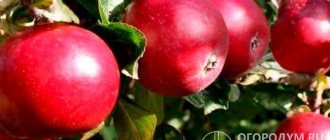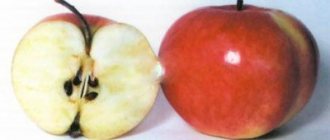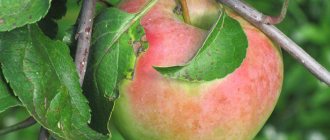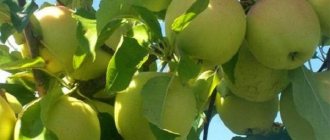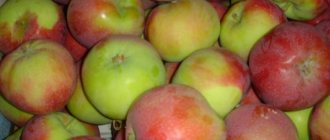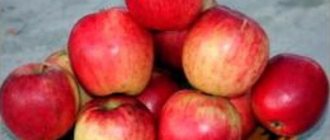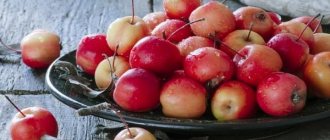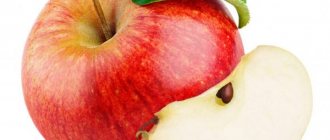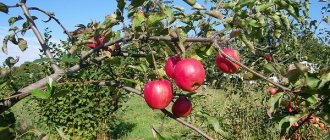Characteristics of the variety
There are more than 100 species that share characteristics with this apple tree. Such varieties may differ in external features and taste.
Description of the tree and fruits
The crown of an apple tree has an oval shape in the initial stages of tree development, but over the years it begins to press against the edges, forming a round shape. The branches grow wide, occupying a large space.
Although the buds open quite quickly, young shoots appear slowly. Fruits that appear no earlier than 1 year after planting usually form ovaries on twigs and growths.
If trees are planted on frost-resistant seedlings, they can live up to 35 years, and if they are planted on stilts of medium height, they can live up to 25 years.
The apples of this variety are quite large and weigh from 150 to 250 g. The description says that their shape is round, but sometimes there are fruits that are slightly flattened on both sides, with roughness in the calyx area. The peel of the fruit is of medium thickness and has a sweetish taste.
The calorie content of an apple is 45 kcal per 100 g. Its nutritional value has the following characteristics:
- carbohydrates – 12 g;
- fats – 0.5 g;
- proteins – 0.5 g.
Sometimes the fruit is covered with a kind of rusty mesh. The pulp of the fruit has a light yellow tint and a dense structure, and its aroma attracts with its sweetness. Often the color of the apple is yellow-green with a red blush on the sides and closer to the stem. The pulp has a sweet and sour aftertaste with varying degrees of astringency.
Productivity
The first harvest can be carried out already 2-3 years after planting the tree. On average, during the first 10 years it can produce 15 kg of apples per year of fruiting. Subsequently, about 60 kg of crops are harvested from one tree each season. The apples ripen in mid-September, when a purple tint appears on their sides.
Pollinators and clones
Apples may vary in appearance
Breeders have bred a huge number of clones of this variety. Among them, these varieties stand out:
- fruits with a smoothly stretched red crimson over the entire surface - Rubin-Star, Jomured;
- apples with a bright red, slightly blurred color - King Jonagold, Jonica;
- varieties with dark crimson colors, on which stripes are sometimes visible - Jonagold Decosta, Jonagored;
- fruits whose color varies from the lightest to the darkest are Novayo;
- fruits of bright colors with clear lines - Wilmut.
It is recommended to plant several pollinator trees next to the Jonagold apple tree. The most suitable varieties are Champion, Jonathan, Idared, Melrose, etc.
Frost resistance
The apple tree variety is often classified as an early winter variety, because Harvest at the end of September. If stored properly, the fruits may not lose their taste until mid-spring. It is recommended to grow the tree in regions with moderately cold winters, because... Low temperature changes are dangerous for him.
Resistance to diseases and pests
The Jonagold apple tree can easily tolerate diseases and pests when special products and solutions are applied. The description suggests that most often the crop is affected by scab, but this variety is resistant to it.
Frequent pests of trees such as apple trees are codling moths, apple moths, silkworms, etc. Powdery mildew is one of the main enemies of the crop, because signs of this disease can appear at any time of the year. This disease is known for causing white spots on foliage (fungal spores).
If no action is taken, the spots darken and spread throughout the tree: to the shoots and fruits. In the spring, the shoots must be treated with Bordeaux solution. During the period when the buds begin to bloom, it is recommended to spray the tree with products containing a high copper content.
Growing regions
The regions for cultivating this apple variety are quite diverse and occupy large areas with moderately cold winters. Such places have a predominantly temperate and warm climate. You can grow apple trees in Ukraine, Belarus, America, and in the central and southern parts of Russia.
Peculiarities
The Jonagold apple tree variety has very distinguished parents - Jonathan and Semerenko. From them he received his taste, shelf life and wood characteristics. The apple tree has more than a hundred clones, which differ slightly in their characteristics.
Jonagold apples.
Most often, the difference is color saturation. But there are other properties too. The most famous are:
- Wilmut and New Jonagold - owners of a bright red striped blurred blush;
- Jonika, Nicobel and King Jonagold - with a bright blush;
- Novayo - with a dark red skin coating;
- Jonagored and Jonagold Decosta - have large fruits with a dark red blush over the entire surface;
- Rubinstar and Marnika are dark red over the entire solid surface.
An apple tree cannot be self-pollinating. She needs neighbors blooming at the same time. And there must be at least three of them. Then fruiting will be as abundant as possible.
Growing areas
The variety can be grown in any territory except the North, where severe cold prevails. Almost any state in America, Europe, Ukraine, Belarus will do. In Russia, apple trees can be planted in the middle zone and in the South.
Tree height
The apple tree itself is quite tall. It can grow up to 7 meters. But cultivation is also possible on a dwarf rootstock. Then the growth of the apple tree does not reach more than 3 meters. The height is also affected by the shape of the crown.
Crown width
The crown is powerful and spreading. The branches are formed at an obtuse angle and extend evenly from the trunk. But its width can be adjusted by pruning, which will depend on the rootstock and the height of the tree itself.
Ripe apples.
Productivity
An apple tree can produce about 15 kg of apples before reaching the age of seven. But an adult and respectable tree can produce up to 100 kg of large, tasty fruits. Moreover, the yield does not depend on weather conditions or other influences. The fruits ripen regularly every year, provided that neighbors are planted, which become pollinators.
Tasting assessment
Everyone evaluates the taste of the fruits of the Jonagold variety as high, even very high. But the exact figure could not be found. Some put it from 4 to 4.3, while in other sources it reaches 4.8 points out of five maximum.
Winter hardiness
The variety's resistance to cold is described as average. But in fact, it is even below average or quite low. It happens that after severe winter frosts the apple tree does not grow, and after a few years it has to be uprooted.
However, you can try to increase winter hardiness. To do this, you can plant the variety on a stable rootstock. It is also important to care for the apple tree and carry out agrotechnical measures for insulation.
Disease resistance
The apple tree cannot be called immune. This is a significant drawback. Immunity to scab is average, and to powdery mildew and other fungi even less. Therefore, during the care process it is necessary to carry out preventive spraying with copper-containing preparations.
Powdery mildew on an apple tree.
Lifespan of a tree
An apple tree usually lives for about 25-35 years. But this figure may vary depending on the growth of the apple tree and the climatic conditions in which the tree grows. The rootstock plays an important role. Semi-dwarfs live shorter lives than tall ones.
Landing
It is recommended to plant trees in spring or autumn before the first frost. In spring, this period occupies the end of April - beginning of May. Planting should be done in loose, well-fertilized soil.
The Jonagold apple tree variety loves well-lit places, so it is better for it to allocate an area that will not be darkened.
The landing site should have the following parameters: diameter – 1 m and depth – 70 cm. The bottom of this pit should have a loose consistency. It is recommended to fill half of the depression with fertile soil mixed with fertilizers.
Place the seedling in the hole. Please note that the grafting site should be 10 centimeters above ground level. Fluff the roots over the entire area and sprinkle with soil.
Water the tree with up to 40 liters of water. During the development of the apple tree, it is necessary to provide it with abundant watering and fertilizing.
Also, the distance at which trees should be planted depends on the type of rootstock: dwarf (2 m), semi-dwarf (3 m) and vigorous (3.5 m).
Fertilizing is simply necessary for fruit production
To get a good harvest in the fall, you should carry out a set of agricultural technology measures, which includes these basic procedures:
- watering. The Jonagold apple tree is a dry-resistant variety, but still requires abundant watering. This is necessary to get large, juicy fruits regardless of weather conditions. Seedlings especially require watering, as water helps them better absorb minerals from the soil;
- fertilizing is useful during all periods of tree formation; it is applied to the very root and the space around it. In the area around the trunk, it is recommended to periodically plow the soil so that the air well permeates all layers of soil and saturates the root system. For the winter, it is necessary to mulch the apple tree with humus, hay or humus;
- Crown pruning plays an important role in the formation of a healthy tree. It is not recommended to prune seedlings until the main part of the tree has formed. The crown is formed 2-3 years after planting. In the spring, it is necessary to carry out sanitary, formative and rejuvenating pruning, with the help of which most of the nutrients can be transferred to the fruits, removing unnecessary branches. There are several suitable crown shapes: cup-shaped, bush-shaped and spindle-shaped. If in the early stages the branches growing upward are pruned, at a later stage of the tree’s development it is recommended to prune the side crown.
Features of ripening and fruiting
There are a number of conditions under which an apple tree will bear fruit abundantly and for a long time. They are not complicated, but it is better to familiarize yourself with them in advance.
Beginning of fruiting
The variety can be called early because the first fruits can be collected in the second year. But don’t delude yourself, because there will be very few first fruits. The number of fruits will increase every year. It will only be fully functional in 10 years.
Fruit ripening
September marks the period of harvest maturity, not consumer maturity. It will be possible to eat apples only in December, when they have acquired the full spectrum of their taste.
Storage and harvesting
Fruit harvesting should be carried out in September. Under the right temperature and humidity conditions, apples can be stored until spring. But then the temperature should be about 2-3 degrees. At higher temperatures, fruits spoil faster.
Apple harvest.
Ripening, collecting and storing fruits
With proper planting and care, you can get your first harvest within 2-3 years after planting the apple tree. In the future, the number of fruits will only increase. Apples begin to ripen in mid-September, and picking can begin in early October.
During this period, the fruits will have a yellowish color with pinkish splashes. Sometimes you may even find green fruits, but don’t worry about it. Over the course of a couple of months, the apple will ripen and acquire a reddish tint.
Full ripeness is observed already in January, when the fruit acquires its best taste and aroma.
The harvest volume depends on the age of the tree:
- 7-8 years – up to 15 kg of apples;
- 9-13 years – you can get up to 50 kg of fruit;
- apple trees over 13 years old bring up to 80 kg per tree.
You can store apples in the refrigerator at a temperature of 2-3 °C. With this approach, this variety can last until April. The higher the temperature at which the crop is stored, the less time the apples will remain edible.
Harvest and storage
Ripe Jonagold apples begin to be picked from the tree in the second half of September, and they reach consumer maturity only in January during storage.
Important! To keep Jonagold apples longer, it is recommended to pick them from the tree along with the stalks.
Basic recommendations for harvesting and storing the crop are as follows:
- fruits must be collected by hand, protecting them from mechanical damage;
- It is recommended to collect fruits in dry weather;
- Only apples with smooth skin without damaged or rotten areas are suitable for storage;
- each fruit is wrapped in a layer of paper and placed in prepared wooden or plastic containers with the stalks facing up;
- in a dark and cool basement at an air temperature of about +5°C, the shelf life of fruit is 4–5 months;
- Apples can be stored in the refrigerator for up to 7–8 months at a temperature of +2…+3°C.
During long-term storage, the fruits of this variety become less tasty and juicy, so Jonagold apples are eaten only during the first months after harvest. It is recommended to process the remaining fruits into juices, fruit purees and canned products.
The Jonagold apple tree can please the gardener with a generous harvest of tasty and healthy fruits that are highly transportable and have excellent shelf life. To grow a beautiful and consistently fruit-bearing tree, it is enough to adhere to the listed care recommendations and promptly combat diseases and pests.
Species diversity
With various crossings of trees, quite popular varieties of the Jonagold apple tree were developed:
- King. The fruits are yellow with red splashes. It has high resistance to diseases and frost. In terms of their structure, these are low-growing trees with apples weighing 150 g;
- Morens is the most popular variety of the variety, with high tasting scores - up to 5 points. The fruits weigh up to 230 g and are stored for up to 7 months from October. The fruits are resistant to low temperatures and have good immunity.
Jonagold (apple tree): description
Jonagold is a winter apple tree. It is obtained by crossing the very well known Golden Delicious and Jonathan varieties. This happened in the middle of the last century in America. This variety came to us a couple of decades later, and gardeners immediately paid attention to it. Industrial cultivation began.
Jonagold apple tree (photo) is popular not only in the USA. There she is among the top 15 most requested. It is one of the most commonly grown varieties in Belgium. It is valued for its large fruits, although its price is low.
The Jonagold apple tree is of medium height and in the first years of its life has a wide, rounded crown. Then, at the time of full fruiting, it becomes broadly oval. The density of young branches is average. The crown shape does not require special adjustments. Skeletal branches grow at such an angle that they do not need to be adjusted.
Every year an average number of young branches are formed on the tree. The tree bears fruit on ringlets, annual growth and fruit branches.
The Jonagold apple tree begins to bear fruit quite early, in the third year after being planted in a permanent place.
The description and photo indicate that the fruits are larger than average in size, reaching up to 9 cm in diameter. The weight of one fruit is up to 220 g. The apples are the same size, round. The color is yellow, with a red or orange blush covering two-thirds of the fruit. The skin is medium thick, shiny, covered with a waxy coating. The pulp is very tasty, aromatic, with a wine flavor, sweet and sour (4.6 b.), yellow in color.
The fruits reach removable ripeness at the end of September, a week earlier than the mother variety Golden Delicious. It is then that they are removed from the trees and stored.
They can be stored in a cellar or other premises of this type. There they can retain their taste until February. If you use the refrigerator for storage, you can enjoy fresh Jonagold apples in April.
Description of the Jonagold apple tree variety
It is rare that an apple orchard around the world does not have at least one apple tree of this variety. Almost everyone likes it for its special ease of care and sufficient level of resistance to cold and disease. Its fruits are very tasty, juicy and pleasant, they are easy to transport, and most importantly, have a long shelf life. It is recommended to grow the variety both in small household plots and in large commercial intensive gardens.
Apples: what it looks like
The fruits are usually quite large, at least above average size. They can grow up to 180-230 grams, and in some cases even more than a quarter of a kilogram. They are round, but can be slightly elongated, elongated, one-dimensional, with faintly visible ribbing. The skin is of medium density and hardness, smooth, glossy, and may have a fairly strong waxy coating. It is quite elastic, due to which high transport qualities are achieved. It is green in color and becomes greenish-yellow over time. The integumentary blush occupies no more than 80% of the surface; it is red-brown or orange-red, blurred and streaked. The chemical composition is characterized by the following indicators per 100 grams of product:
- P-active substances (catechins) – 147 milligrams.
- Ascorbic acid (vitamin C) – 6.4 milligrams.
- Total sugars (fructose) – 11.2%.
- Pectins (fiber) – 5.6%.
- Titratable acids – 0.48%.
The flesh of the fruit is initially greenish, but then becomes increasingly lighter, white, creamy or slightly yellowish. It is dense, fine-grained, very juicy, pungent, sweet and sour, balanced and harmonious, dessert taste. It has its own peculiarity - a certain astringency, a kind of astringent aftertaste, which diversifies the overall impression. The tasting rating of professionals is 4.6 and 4.8 points on a 5-point scale.
Apple tree Jonagold: characteristics
Crown and root system
Trees of this variety are very tall. They can easily grow above 6-7 meters in the absence of pruning .
Jonagold falls slightly short of the powerful Hornist or Aphrodite, but the crown of an adult trunk can easily cover approximately 4-6 meters in diameter. At a young age it has a pyramidal, oval or spherical shape, but over time it becomes more and more dome-shaped, and sometimes even spreading and spreading. The shoots are long, straight, and mostly extend from the trunk at a right angle, which helps them not break off even with fairly significant harvests. The tree bears fruit on ringlets, annual growths and fruit twigs. The bark is greenish-brown or slightly steely gray and slightly pubescent. The leaves are large, leathery, rounded, have a finely jagged edge and an elongated pointed tip. The root system is extremely powerful, deeply recessed, branched, in some cases covering an area of up to 5-6 meters in diameter, which allows the tree to stay firmly on the surface even during hurricane winds.
Productivity and pollination
These apple trees are really distinguished by early fruiting and bear the first fruits by 3-4 years. However, you shouldn’t make rosy plans, because by 8-9 years you will be able to collect no more than 10-20 kilograms of fragrant fruits.
The maximum yield of Jonagold can be expected only at 17-20 years of age. Then from one adult trunk it will be possible to collect 75-115 kilograms of apples. The maximum recorded result is 180 kilograms with good care and favorable climatic conditions. The weather does not have much influence on the yield of trees, so there is no need to worry about a rainy summer.
The variety is considered triploid. That is, for itself it is completely sterile, but that’s not all: pollination requires two or more pollinators, which is why Jonagold is planted interspersed with several other varieties.
Winter hardiness and disease resistance
Trees have very conditional resistance to low temperatures. Frosts below -18-20°C, which last more than a week, are destructive for them. The variety also does not like sudden changes from bitter frost to thaw with above-zero temperatures.
In the eighties, in Ukrainian Polesie the thermometer suddenly dropped below -32°C. Despite the fact that the trees were covered for the winter, they received critical damage: not only young shoots and bark, but also the wood were frozen. They were never able to recover in 2-3 years, so they had to be cut down and replaced with others.
Apple trees are susceptible to various fungal apple infections, like most others. They are quickly and abundantly affected by powdery mildew, scab and other “delights”, so you need to strictly monitor all care measures, including treatment with fungicides.
Rootstocks and subspecies
The trunks are grown on different rootstocks, which can give them slightly different characteristics.
The Jonagold variety has more than a hundred clones, which has virtually no analogues among apple trees. For ease of classification, scientists divided them into five main subgroups based on the color of the integumentary blush.
| Subspecies | Description |
| Morrens | This is the most popular Jonagold subspecies in the world. Other names of the subvariety are no less known: Highlander, Jonagored, Jonagored Morrens Supra. It is believed that it was not artificially bred, but appeared as a result of accidental pollination in Belgium in the mid-eighties. It has large apples 165-230 grams, which ripen in early October and can last until the new harvest. It is considered one of the ten best apple varieties in the world with a tasting score of 4.8-4.9 out of 5 points. |
| Dwarf and semi-dwarf | Jonagold, grown on MM-106 and M-9 rootstocks, is characterized by its short stature, only 2.5-3 meters. It begins to bear fruit early, produces good offspring, can withstand lower temperatures and is not afraid of disease, moisture, or dampness. However, the active life of trees is reduced to a maximum of 20-35 years. After this, they will have to be uprooted and replaced with young ones. |
| King | The subvariety is even smaller in height, but its main feature is a uniform, beautiful red-orange integumentary blush, occupying approximately 95-98% of the fruit. The trunks have increased resistance to scab, powdery mildew, moniliosis and other infections, and tolerate frosts down to -20°C. |
Usage
Jonagold apples tolerate transportation well, so they can be transported over long distances.
Apples of this variety are used to make juices and wine. From the bottom they produce puree and dry powders. What do the gardeners who grow the Jonagold apple tree say? Reviews say that at home, jams, preserves, compotes are made from apples of this variety, and used as a filling for pies. But they consider the best use to be eating fresh apples, because they are very tasty and aromatic.
Advantages of columnar apple trees
- Possibility of growing a large number of fruit trees in small areas.
- Productive use of the tree trunk circle, in which, due to the lack of shade, not only decorative but also vegetable crops can grow.
- Convenient implementation of a set of tree care measures.
- A small volume of the root system allows for close planting to the tree.
- Excellent decorative effect both during flowering and during fruiting of plants.
- Early fruiting (getting the first apples already in the first or second year after planting).
- High productivity, superior to traditional apple trees (especially in the first years of harvest).
- Competitive taste properties that characterize familiar apples.
- Ergonomic apple picking, eliminating the use of traumatic devices.
- Quick return on investment for growing a garden due to high early fruiting and productivity.
- Possibility of effective wintering of a short tree, which is sometimes completely covered from frost.
Growing
You can plant an apple tree in autumn or spring. It is believed that the Jonagold apple tree variety takes root better in the fall. But for this it needs to be planted correctly.
The hole for the seedling is prepared in advance, two weeks before planting. Its size should be sufficient to accommodate the root and provide it with a set of useful substances. Having prepared a hole 1 m deep, loosen the soil. This allows the roots of the plant to grow unhindered in depth and to the sides for several years. The length and width of the pit are also 1 m.
The soil for planting an apple tree should be neutral acidic, pH 5.0-6.5. The layer of chernozem or humus layer must be at least 18 cm. The apple tree does not tolerate stagnation of water in the root system. The groundwater level should not be less than 1.5 m. Apple trees do not grow on swampy soils and peat bogs.
The top layer of soil is laid separately. Fertilizers and substances beneficial to the seedling are added. This is rotted manure, a handful of ash. You can add complex or potassium-phosphorus fertilizers.
A mound of prepared soil is placed at the bottom of the hole. A seedling is placed on it. Straighten the roots so that they are directed to the sides of the mound. Place a peg in the hole to which the seedling will be tied. Carefully fill the remaining space with earth, compacting it periodically.
Watered. Up to 30 liters of water are poured under one tree. Then the tree trunk circle is mulched with a thick layer of peat, humus, hay or mowed grass. This especially needs to be done in the spring. Mulch will help retain moisture near the plant's roots and prevent weeds from choking it out. Water deeply once or twice a week. This largely depends on the weather and soil conditions.
In spring they are planted 5 days after the soil thaws. In autumn - two weeks before the onset of stable frosts.
When planting, make sure that the planting site is located at a height of at least 10 cm above the soil level. The distance between apple trees should be at least 4.5 m.
Crown formation
Jonagold is an apple tree that does not require special pruning. Its skeletal branches grow at the right angle. Therefore, the main task is to form a crown by cutting the conductor 40 cm from the upper branch of the lower tier, and leaving the required number of skeletal branches (4-6).
If the tree is weak, the lower tier consists of 3-4 branches, the conductor is cut to 20 cm. The next year it is shortened again by 40 cm. After 4 years of such procedures, the conductor is cut out at a height of 2.5 m, transferring it to a side branch.
Subsequently, branches growing into the crown or crossing are removed. Damaged or diseased ones are pruned. The crown is constantly maintained in a cone shape.
Feeding
In the first 4 years of life (in the second year after planting), nitrogen fertilizers are applied to promote the growth of the apple tree. When the branches or root system freeze, which can happen in the Jonagold apple tree, use foliar feeding with a 0.5 percent urea solution. The first time is carried out a couple of weeks after flowering, the second time after another two weeks. Potassium chloride is added to the solution.
Foliar feeding with preparations containing boron promotes better fruit set.
